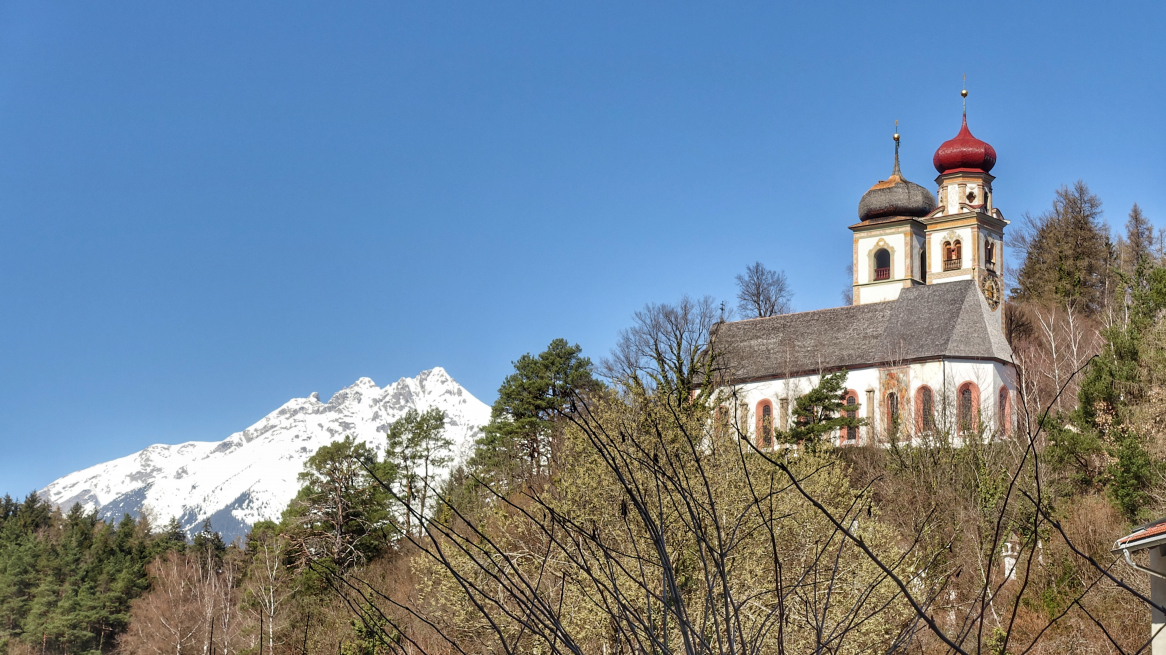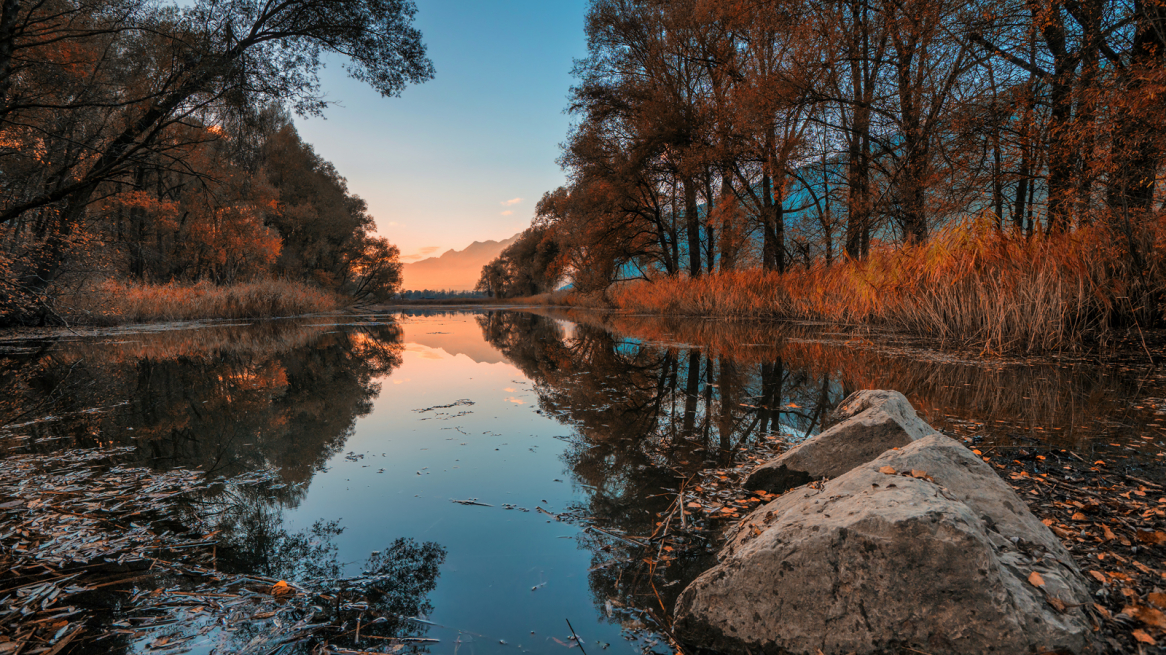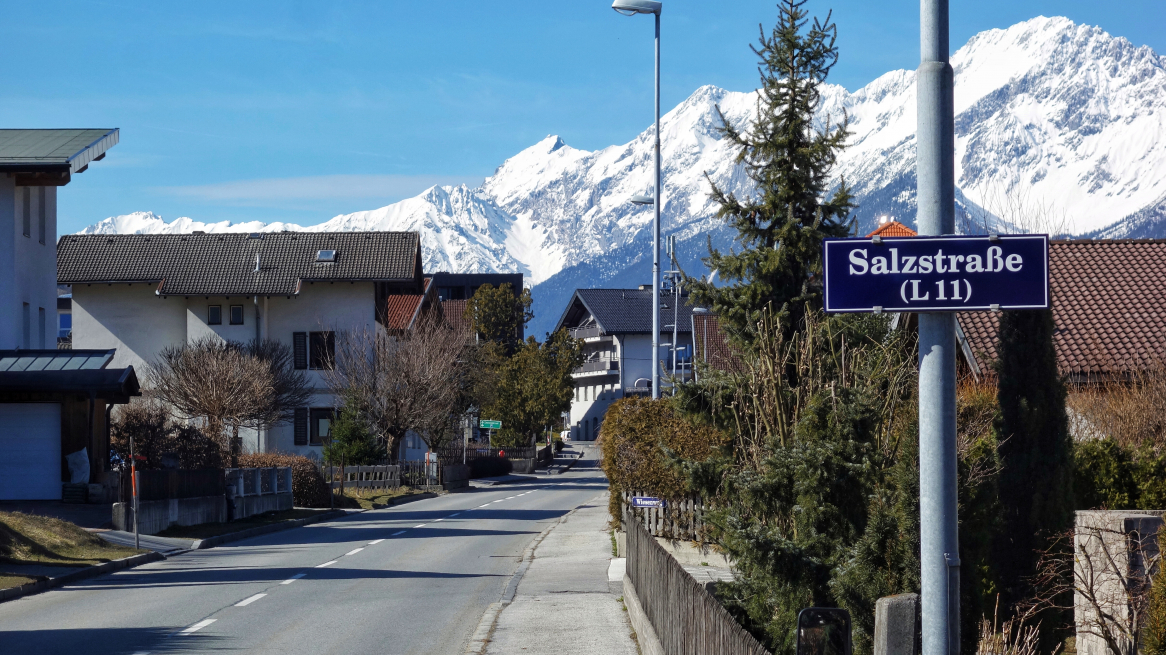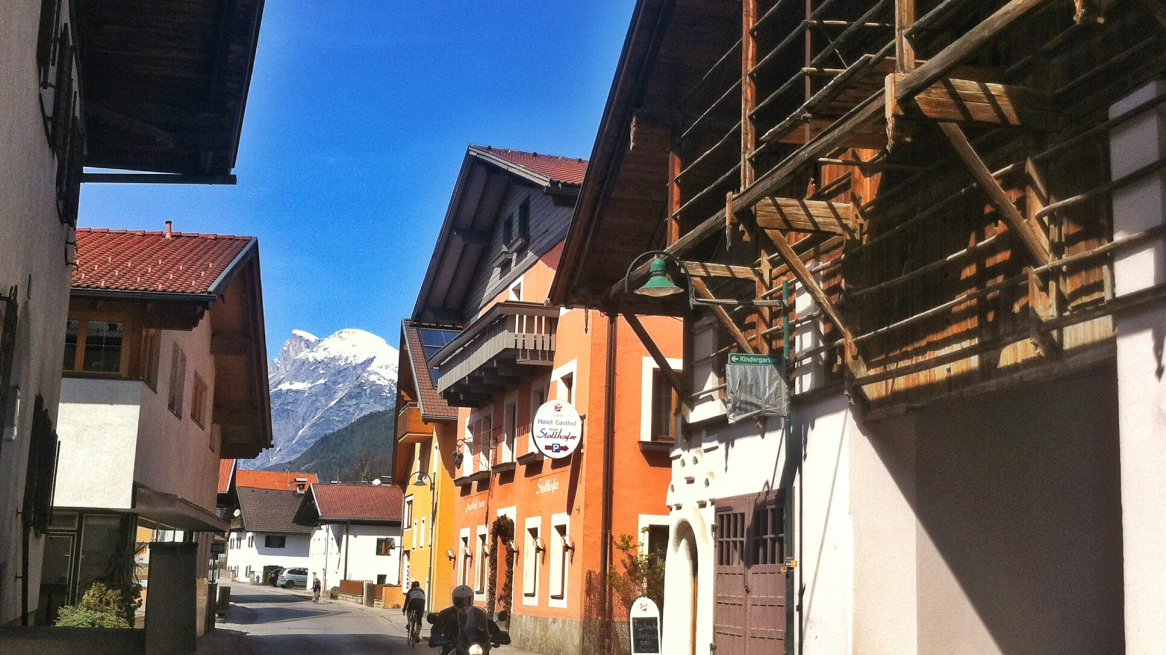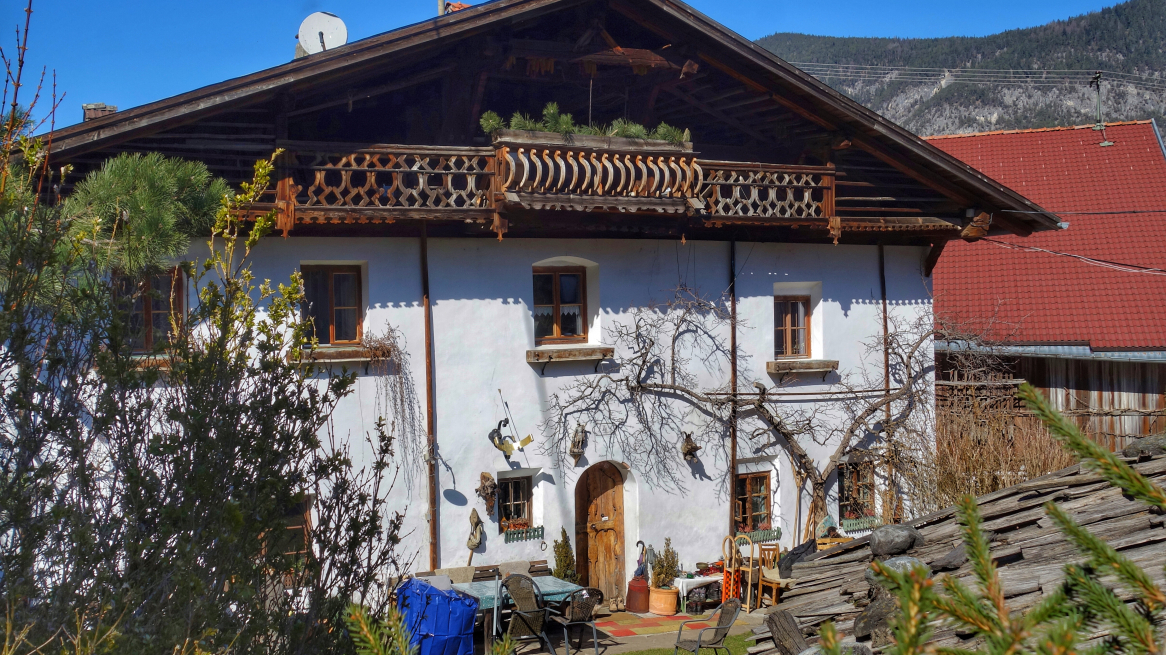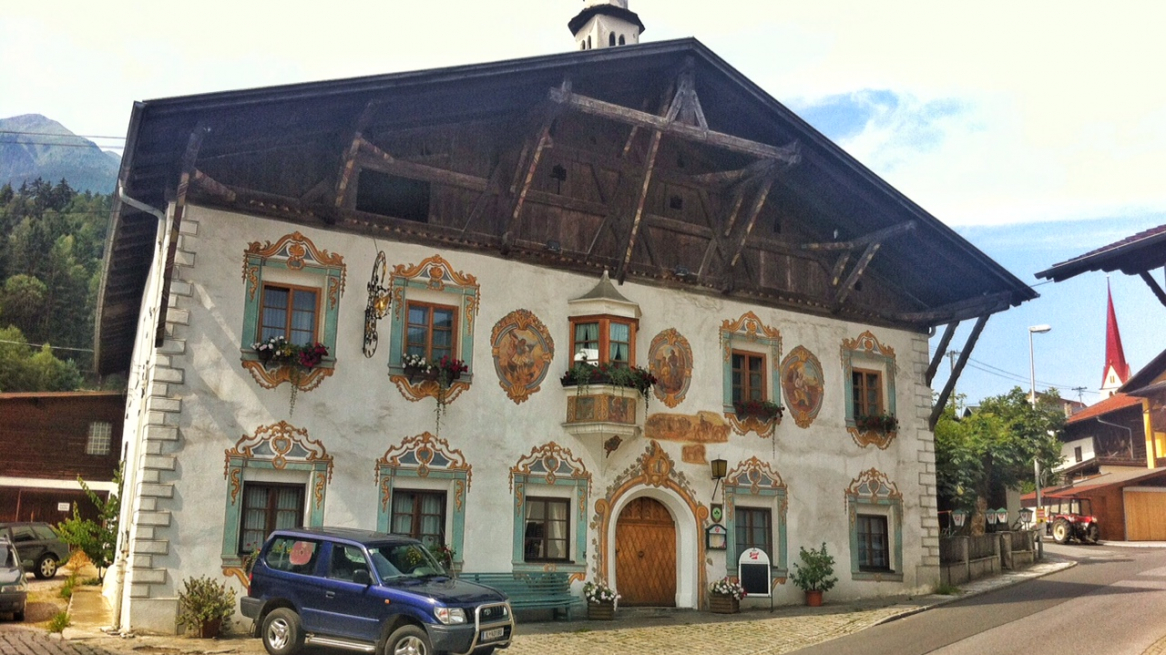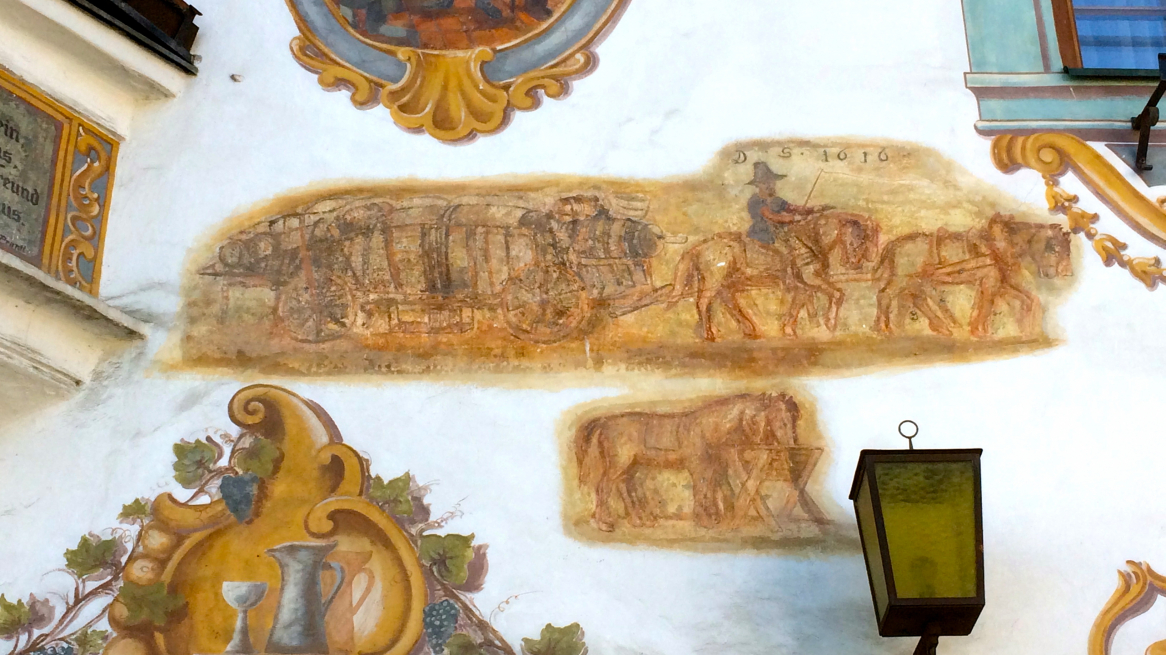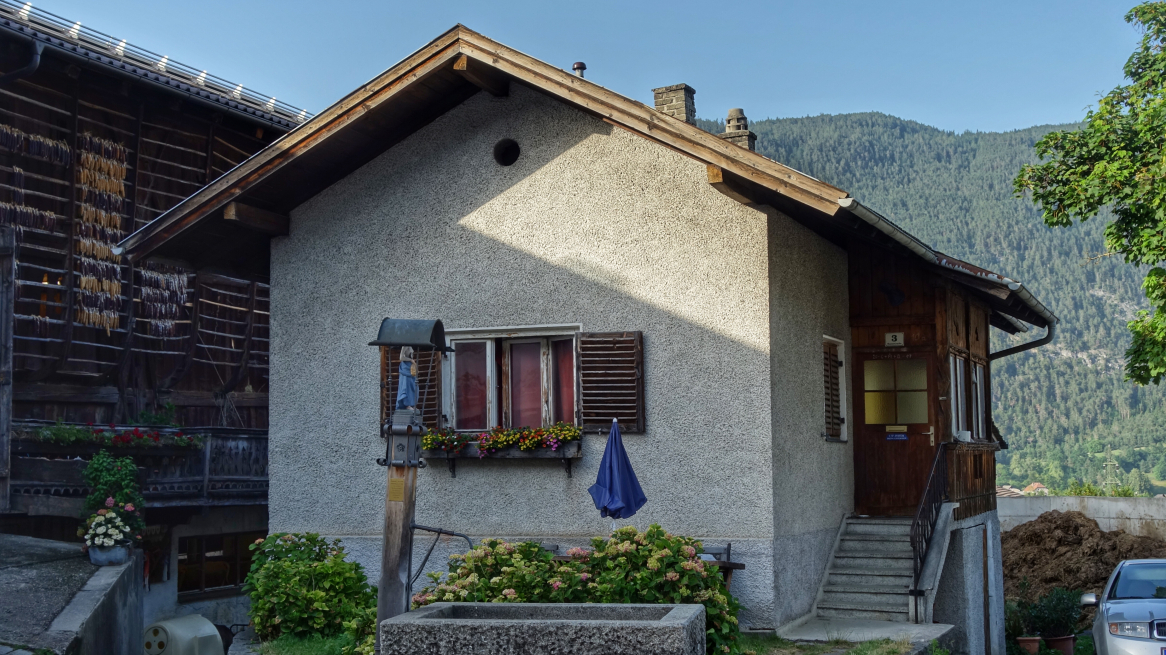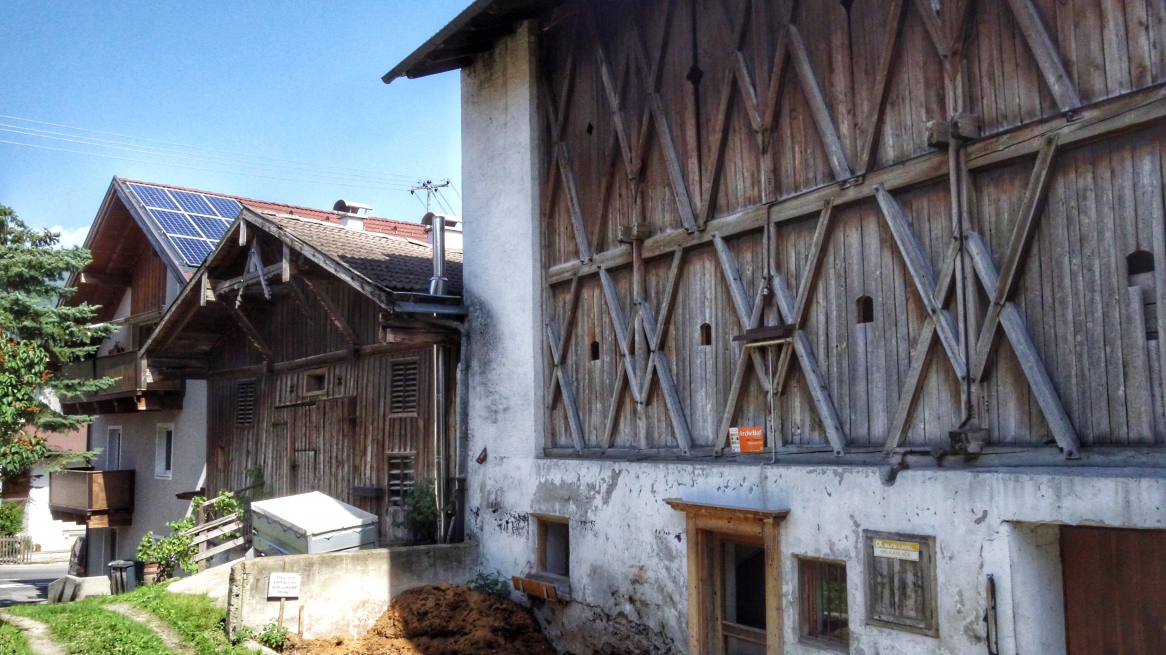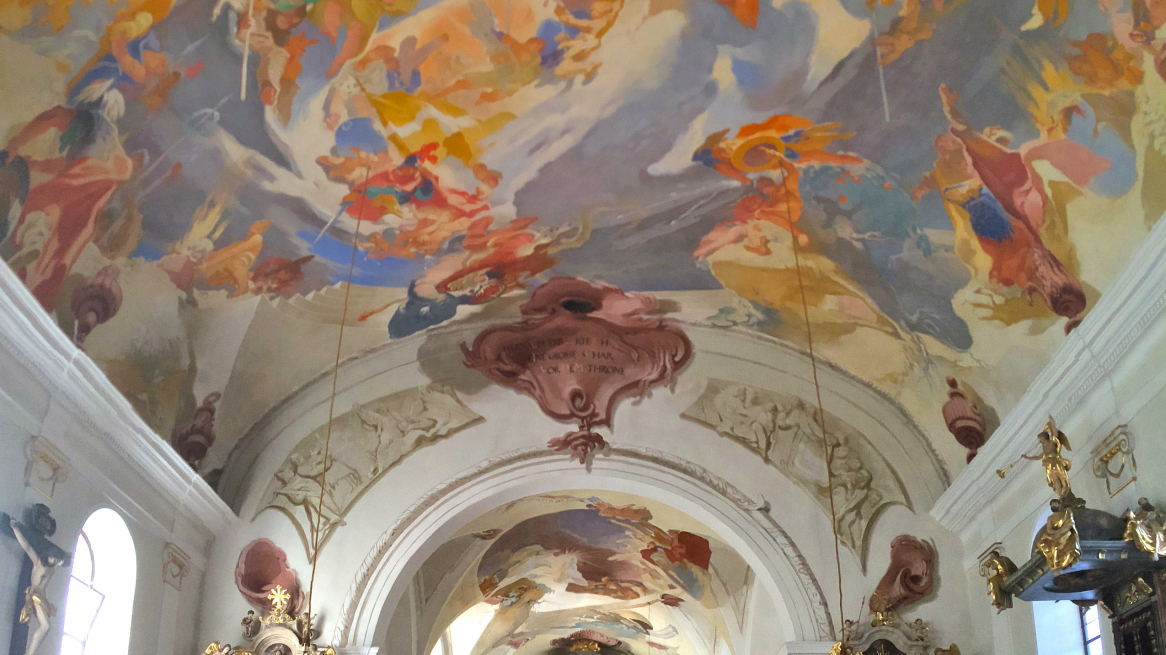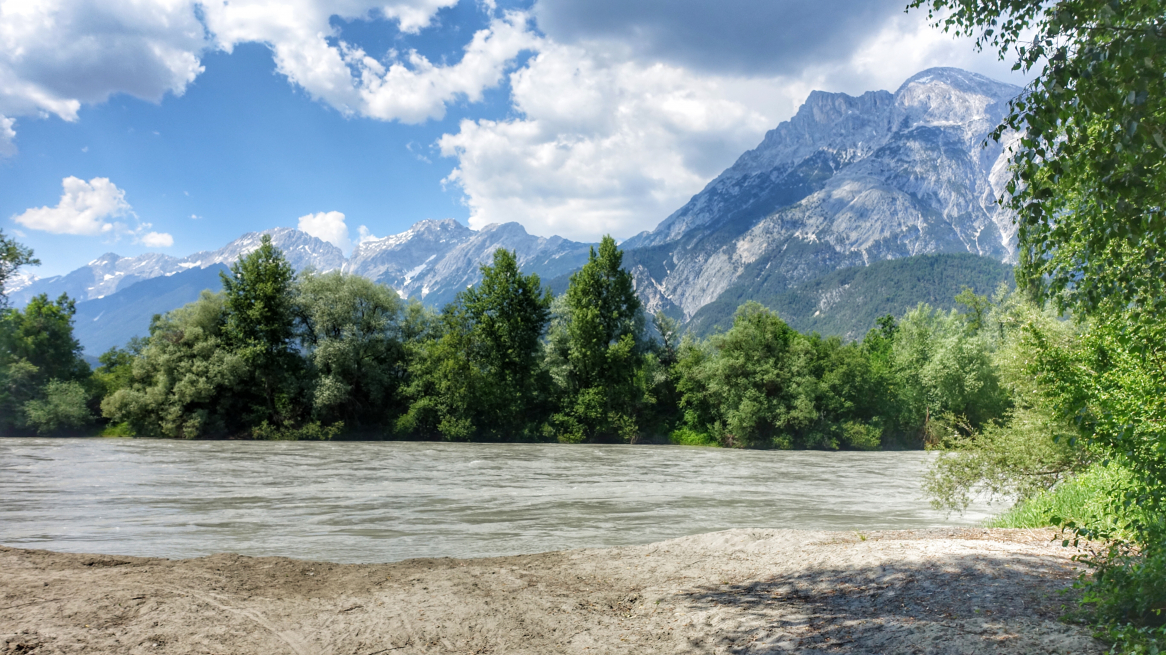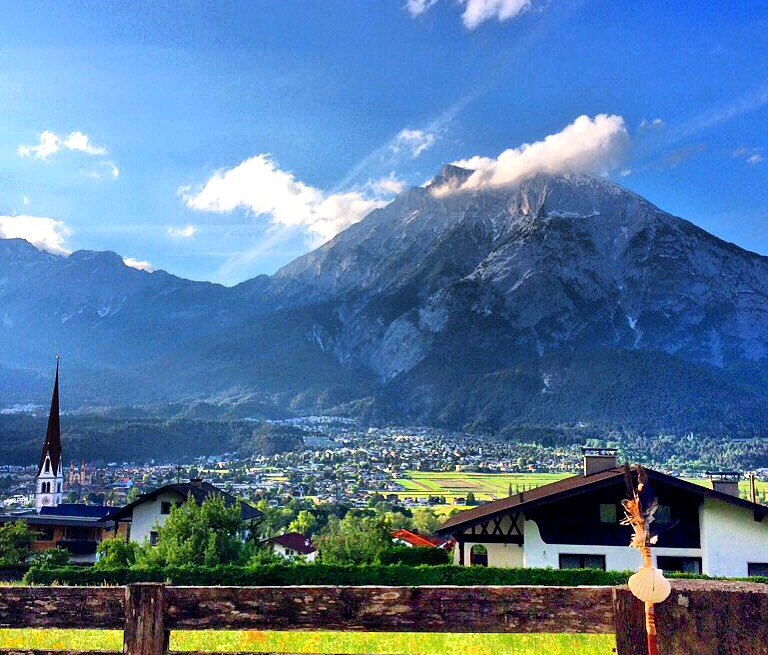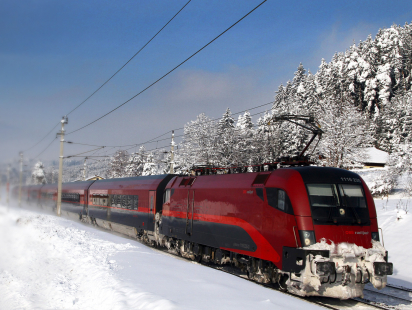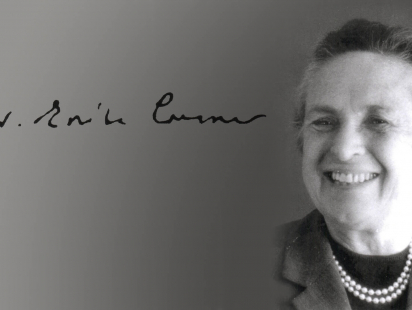A third Tyrolean salt road owed its rise to a bridge over the Inn at Zirl. It subsequently led south of the river via Inzing, Hatting, Polling, Flaurling and Oberhofen to Pfaffenhofen and was ideal for winter transport on sledges due to its shady location. On a route that had already been used by the Romans.
The salt road between Zirl and Pfaffenhofen. Detail from the map of Johann Martin Gumpp the Elder, Inntal und Außerfern, end of the 17th century, scale 1:65000. Image: tiris
With the presentation of former Tyrolean salt roads, I would like to recall the history of landscapes on the one hand. On the other hand, I want to draw attention to buildings, churches and residences that today lead a mostly Sleeping Beauty-like existence away from the main traffic routes. Completely unjustly, in my opinion
A ROAD WITH A PREHISTORIC PAST
Excavations in recent years impressively prove that there had certainly been a prehistoric transport connection south of the Inn. It is hard to believe, but on the slope of today's castle ruins Hörtenberg ob Pfaffenhofen extended the largest Iron Age settlement in North Tyrol. This also means that there must have been connections in the direction of the Unterland and also to the Oberland. Why this large Iron Age settlement and cult site had existed since 800 BC in what is now Pfaffenhofen, of all places, is quickly explained: the Inn left its narrow valley area for the first time at this point and widened. A first ideal place to cross it. Pfaffenhofen was thus a prehistoric bridgehead on the way to the foothills of the Alps.
Here, at the foot of the ruins of Hörtenberg Castle above Pfaffenhofen, was the largest Iron Age settlement in North Tyrol some 2,000 years ago.
The excavations at Hörtenberg in Pfaffenhofen. In the background the cult mound of the large Iron Age settlement.
THE ROMANS USED THIS ROAD INTENSIVELY
It is very likely that the Romans transported salt from a brewhouse in Thaur via Ampass, Wilten, Völs, Kematen and Inzing to Pfaffenhofen. This is where the Inn bridge was located, which made a connection to the Roman Limes in what is now southern Germany possible.
For a long time Ampass was the 'eye of a needle' through which the salt transports also reached the west.
In addition, the Roman cavalry horses in particular needed salt. It can be assumed that the extensive Inn meadows between Inzing and Pfaffenhofen served the Romans as horse stations. So it can be rightly assumed that the connection between Kematen and Pfaffenhofen had already been a kind of 'Roman salt road been a way of life. Long before salt became the 'white gold' of Tyrol in the Middle Ages.
The Inn meandered through the valley like a snake in the Middle Ages. Here a former branch of the Inn in Inzing. © Innsbruck Tourism
THE ROMAN ROAD DIVIDED IN KEMATEN
The discovery of a Roman road station at Michelfeld near Kematen indicates that some kind of branch-off already existed in today's Kematen in Roman Imperial times. One of these 'Roman roads' led in the direction of Martinsbühel, the Roman fortification 'Teriolis' at that time. The Inn crossing there opened up the route to the German Alpine foothills via Zirl and the Zirlerberg. This road connection was particularly important, as it ensured the supply of Roman troops at the Limes, the Roman protective wall against the attacking Germanic tribes. The other 'Roman road' followed the prehistoric route via Inzing to Pfaffenhofen.
ZIRL - ONCE A HUB FOR THE FLOW OF GOODS
For me, it is always interesting what kind of past places have. An excellent example of this is Zirl. The Martinsbühel in Zirl was already of great strategic importance in Roman times. The place held this position until the end of the Middle Ages. Goods of all kinds, but above all the valuable salt, were transshipped in Zirl, the destinations of which were in southern Germany or Switzerland. Zirl's decline only began in the middle of the 19th century with the construction of the Arlberg railway.
THE ZIRLER INN BRIDGE OPENS UP NEW TRAFFIC ROUTES
Back to the Middle Ages. When the Zirl Inn bridge was built in 1480, additional new transport connections to the Tyrolean Oberland were opened up. Via Inzing, Hatting, Polling, Flaurling and Oberhofen one reached Pfaffenhofen to the Inn bridge to Telfs. It should be added here that salt transports over the Arlberg and subsequently to Switzerland were impossible for a long time.
Today's bridge over the Inn near Zirl was built on the site where the first bridge was built in 1480.
THE CUSTOMS STATION OF INZING
Inzing was the first major settlement after the crossing of the Inn. The memory of the salt road is only present in a street name. In the middle of the village there was a customs station - a medieval toll station. It is said to have been located opposite the Stollhofer Inn. From this, it can be concluded that the inn was frequented by traders and carters alike.
This is what is left: the 'Salzstraße' in Inzing.
The Gasthof Stollhofer in Inzing is one of the historic inns on the Salzstraße. Vis a vis was the customs station.
It is not known whether the 'Schlössl', once a residence next to the church from the second half of the 13th century, played a role in the salt trade. Nevertheless, as the seat of the lords of Eben and then those of Völs, it was probably not situated on the goods transit route for nothing. The nobility profited from the customs and toll revenues. They were used to financing their lavish lifestyle with unemployed income.
A MIRACLE OF TEARS AS A MEDIEVAL MARKETING GAG
The church, too, was obviously looking for additional income in the Inzing of the Middle Ages. A miracle was needed and was packaged in the form of a 'miracle of tears '. Allegedly, an image of the Virgin Mary wept incessantly, even when it was hung in a specially built - and soon demolished - chapel. A spiritual sleight of hand, which more than 330 years ago flushed massive money into the clerical coffers.
The house of the miracle of tears in Inzing. This is where the miracle of the tears is said to have started.
After Inzing you cross Toblaten with its famous Blasius Hueber House, the Adelshof. St. James pilgrims appreciate the house as a hostel on the way to Santiago. After Toblaten, the Hohe Munde dominates the wonderful scenery. While Polling and Hatting hardly have any remarkable buildings, Flaurling is, in my opinion, one of the most exceptionally beautiful communities in this country.
The noble farm in Toblaten. Once the retirement home of the famous Tyrolean cartographer Blasius Hueber.
FLAURLING, A PEARL ON THE SALZSTRASS
The 'noble' past of the village is revealed in the Ries-Schlössl, which virtually towers over the community. Emperor Maximilian often came here to absolve his sins with his confessor. Or to go stalking for chamois in the mountains above Flaurling.
Flaurling also has one of the most remarkable inns in Tyrol, which is a reminder of the once golden age of the salt trade: the Golden Eagle in Flaurling. Today you can still admire the inn's huge stable building, which once served as a horse changing station. Even remains of the customs station still exist in Flaurling, vis a vis the Goldener Adler.
The legendary 'Golden Eagle' in Flaurling.
Immortalized in exterior frescoes on the Golden Eagle: The luggers at work.
A relic from days long gone: the customs station in Flaurling. Or what is left of it.
I recommend a walk through the village, including a visit to the parish church, to people with an affinity for culture. Originally built in Gothic style, the church was later baroqueized. Normally an outrage for me. Not so in Flaurling: the baroque interior puts the viewer in a kind of jubilant mood that is rarely felt in a church. Moreover, the tomb of Sigmund Ries, the confessor of Emperor Maximilian, is also located in the church.
FARMERS CELEBRATE A MEDIEVAL ANTI-TRUST VICTORY
In Oberhofen, the next town on the salt route, a dispute took place in the middle of the 16th century about the 'Rod' and thus about the right to transport salt. In 1542, farmers from the village began to build their own harbour on the south side of the Inn, complete with salt store. This 'loin' was more favourably situated in terms of flow than that of the Telfer on the opposite side. Telfs, however, objected to the Oberhofen farmers' own land-use order, but the provincial government ruled in favour of the farmers from Oberhofen. In doing so, they broke a quasi-cartel with the Telfer salt carriers, who were subsequently only allowed to transport two-fifths of the barrels in the direction of the Fernpass. The rest was distributed among farmers from Oberhofen, Mieming and farmers from Leutasch. A medieval anti-trust victory, so to speak.
At about this point, farmers from Oberhofen created their own 'loin', i.e. a harbour on the Inn, in 1542.
Oberhofen is also interesting for other reasons. Finds from the Iron Age attest to the millennia-old settlement of the village. Highly recommended is the permanent archaeological exhibition in the Museum of local history Oberhofenwhich is located in the building of the community centre. Here the partly unique finds are presented. I have included a presentation of the finds in pdf format at the end of this text.
PFAFFENHOFEN AND ITS PREHISTORIC PAST
For me, Pfaffenhofen is one of the most interesting places on this salt road. It was not only the largest Rhaetian settlement in northern Tyrol that existed here. The Romans also appreciated today's Pfaffenhofen already 2,000 years ago. Archaeologists assume that a Roman horse station once existed just below today's parish church. Actually logical, if one considers that a journey over the Fernpass at that time was a real test for humans and animals. On the other hand, I now also understand why Pfaffenhofen had already been a Bishop's seat had already been a After all, the Christians had first fully developed their missionary activities along the Roman roads.
Castle ruins Hörtenberg with Hoher Munde.
Pfaffenhofen is also a town on the Tyrolean Way of St James. Here the view of the Hohe Munde.
MY TIPS FOR A CULTURAL TRIP ALONG THE SALT ROAD:
- The distance from Innsbruck to Pfaffenhofen or Telfs is about 32 kilometers.
- For cyclists, the route is quite wonderful. The cycle path between Inzing and Pfaffenhofen runs along the banks of the Inn. The buildings and places described in the blog can be reached within a very short time from the cycle path HERE you can find the map.
- The return trip from Pfaffenhofen to Innsbruck is no problem, the station Telfs-Pfaffenhofen is located in the center of Pfaffenhofen.
- The finest drinking water flows from the fountains in all the villages along the route.
- As announced, the most beautiful prehistoric Findings from Oberhofen.
LINKS TO STORIES ON THE SALT ROAD
The lucrative miracle of tears
Emperor Maximilian in Flaurling
Flaurling, the pearl on the salt road
Pfaffenhofen, a former bishop's seat
All photos, unless otherwise stated: © Werner Kräutler
Rate this article
Show me the location on the map
A volunteer at the "Schule der Alm" alpine farming school, cultural pilgrim, Tyrol aficionado and Innsbruck fan.
Similar articles
The zoo is at the cradle of my love for Tyrol. It awakened in me the longing…
I commute a lot between Innsbruck and Vienna and I know the advantages of both cities. Many…
The darker and colder it gets outside, the cozier and cozier it gets inside. When, if not…
The physical chemist Erika Cremer (1900-1996) is one of the most important research personalities of the University…





